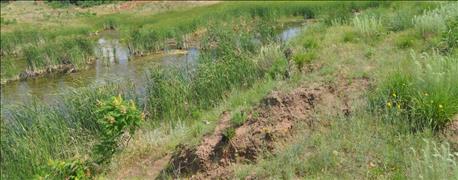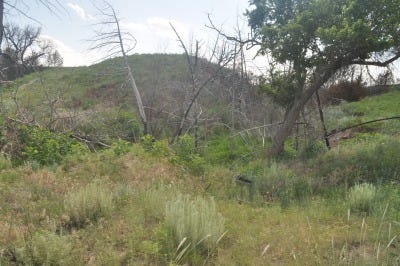
The Anderson Creek Wildfire Cleanup Initiative has established five top priorities that need immediate action to help restore the ecology of the region to far better than its pre-fire condition.
When the devastating fire roared through northern Oklahama and southern Kansas in late March, it took out homes, barns, hay supplies, fences and livestock watering systems.
It killed hundreds of head of cattle and calves and devastated wildlife food supplies.
But it also killed tens of thousands of invasive red cedar trees, including many that were too big or too far down into deep canyons to be killed by prescribed burns.

CLEAN WATER: This beaver pond on Stewart's Creek is an example of the advantages to wildlife that comes with maintaining the natural mixed grass prairie ecosystem.
The newly formed Cleanup Initiative hopes to build on the gift that nature provided in the wildfire by drastically reducing the red cedar population and working to restore the native ecology. They named these five top priorities for doing that.
1. Removal of dead, standing invasive tree skeletons
The top priority says local rancher Ted Alexander, who is leading the Cleanup Initiative, is the removal of dead trees. He says those trees draw birds who perch on the dead branches, dropping the seeds of not only cedars but other invasive species. The tops of productive ridges will get preference.
2. Restoration of water resources

WATER QUALITY: Removing burned and dead tree skeletons from riparan areas is a major goal of the Anderson Creek Wildfire Initiative.
A mature red cedar tree consumes 15 gallons of water per day. Without cedar infestation that water would be available to nourish native grasses. In the Gyp Hills, where annual rainfall is 22 inches per year, a well-managed pasture with no cedars returns about 100,000 gallons of water per acre to groundwater. In pastures infested with 40% to 70% cedar canopy, that recharge is reduced to 20,000 per acre. Clipping small cedar trees and prescribed burn are part of this effort.
3. Restoration of wildlife habitat
The western edge of the wildfire area borders the eastern edge of the Lesser Prairie Chicken habitat, the destruction of which has resulted in the bird bring placed on the threatened species list. If the prairie ecology can be restored, the borders of the prairie chicken habitat can be moved east.
Rancher Ted Alexander has prairie chicken habitat on his land and says he believes the habitat can be extended eastward with good management practices.
4. Re-establishment of native grass and forb species
Many of the burn areas, especially those previously under cedar canopy, have problems getting native grasses re-established. The Initiative will work to reseed native species of grass and forbs in the burned region.
5. Monitoring and control of noxious weeds
Noxious weeds seem to have a way of being stronger and recovering faster. Rancher Ted Alexander is worried that seeds might come in from the well-meaning ranchers who donated hay to their colleagues who lost their own supplies to the fire.
"We don't have a way of monitoring the storage of that hay or where it came from," he said. "It has been a welcome lifesaver. But it might also bring in Serecia Lespedeza, Knapweed, or other problems from other areas. We need to stay vigilant."
RELATED STORY: A chance to gain 20 years of ecological restoration in a single year
About the Author(s)
You May Also Like






